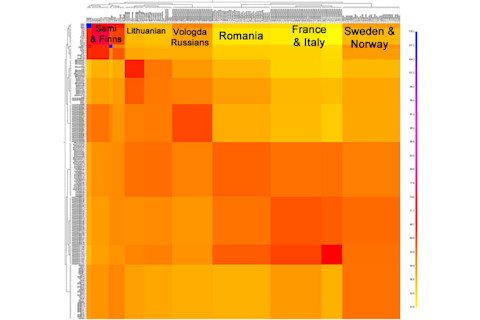The Fennoscandia Project has now gone through chromosomes 1 to 6 with Chromopainter/fineSTRUCTURE. The conclusion:
If we looker at the bigger picture we see that most of continental Europe is tied to each other more trough mutations than others making them harder to seperate even at this level (6 chromosomes). We see that Lithuanians seem to have stronger affiliation to the large continental European cluster including Scandinavians but this affiliation is weaker for Vologda Russians. This connection is even weaker for Finns and almost non-existing for Saamis. This is in accordance with the MDS plot.
Here is the relevant plot (I have added some labels):

The Vologda Russians from the HGDP data set clearly have a substantial Finnic ancestral component. That's because Russia, as the domains populated by Russians, has been expanding north and east for nearly 1,000 years. Much of this occurred via assimilation and acculturation of non-Russian Uralic and Altaic populations. As for the relatively close affinities of the various Finnic peoples, why? There are parts of Finland where it seems that there has been very strong founder effect due to recent expansion of settlement north. But I do not understand how this would relate to the connection with the Sami and other Finnic and Finnic-origin peoples to the east. My own earlier supposition has been that northeast Europe served as a repository of peoples who adopted agriculture late, and were resistant to the expansion of Indo-Europeans. This certainly comports with the fact that there is a rather sharp difference between Finnic and Scandinavian peoples in Norden. Yet the Finnic people are not an archive of deep ancient genetic diversity, as is in the case of African populations such as the Pygmy and Bushmen. But perhaps the African model is not appropriate, as Eurasian populations start from a far lower baseline of genetic diversity? In that case one can imagine that the retreating hunter-gatherers on the boreal fringe may always have been subject to strong genetic drift because of the marginality of their local ecology. (tip Maju)













